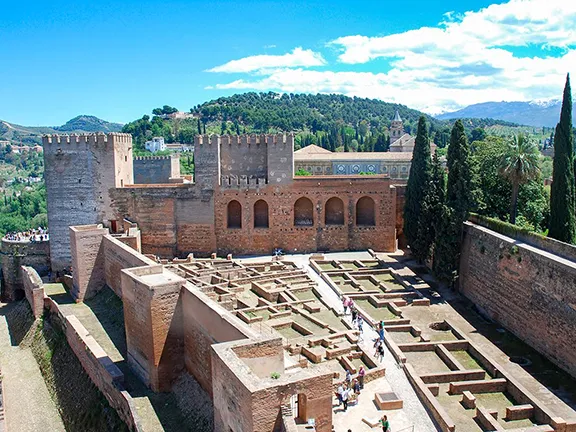The Alhambra in Granada has a history spanning 2000 years from the Romans to the present day.
By Nick Nutter | Updated 1 Nov 2023 | Granada | History |
Login to add to YOUR Favourites or Read Later


Nazrid Palaces Alhambra
The first fortification to be built on al-Sabika Hill, a rocky outcrop overlooking the city of Granada, was probably Roman and their interest in the area would have been the gold placer deposits in the rivers Genal and Darro in the valley below and the gold veins in the rock beneath the Cerro del Sol, the hill behind and overlooking the Generalife.


Alcazabar Alhambra
The first written mention of the fortification is from the 9th century.
At the time, a civil war was destroying the Caliphate of Cordoba, to which Granada belonged. In 889 AD, one Sawwar ben Hamdun had to repair the fort on al-Sabika and take refuge in it.


Alcazabar Alhambra
The next mention is from the 11th century and is part of a fascinating rags to riches story.
Samuel ibn Naghrillah was an Andalusian Jew born in Mérida in 993. In 1009 AD, Samuel was a merchant in Cordoba and was forced to flee to Malaga during the civil war between the Amirid Kingdom and the Berbers who took Cordoba in 1013 AD. The Caliphate of Córdoba collapsed after 1009 and the Fitna (civil war) began, the Zirid leader, Zawi ben Ziri established an independent kingdom for himself, the Taifa of Granada. The Zirids built a palace and citadel on the hill now occupied by the Albaicin district of Granada that became known as the al-Qasaba al-Qadima, or old citadel.


Puerta de la Justica Alhambra
Meanwhile, in Málaga, Samuel set up a spice shop near the residence of the vizier of Granada, Abu al-Kasim ibn al-Arif. He became acquainted with the vizier through the vizier’s maid servant. Eventually Naghrillah was given the job of a tax collector, then a secretary, and finally an assistant vizier of state to the Berber king Habbus al-Muzaffar.
Habbus died in 1038 AD and Samuel was instrumental in making sure Habbus’s second born son, Badis, succeeded him. Badis made Samuel ibn Naghrillah his vizier and top general. His unique position as the viziership made him the highest-ranking Jewish courtier in all of Spain. He also had the unique distinction for 17 years of being a Jew commanding a Muslim army. Samuel was given permission to build a palace on al-Sabika hill.


Video By: Julie Evans


Mediaeval Cannon Balls
Some work was also done on the al-Qasaba al-Jadida, or new citadel, the repaired Roman fort on al-Sabika and the two hills were joined together with a fortified wall that bridged the River Dorro. The remains of this bridge are still visible today.
In the late 11th century, the Taifa Kingdoms, the period of Zirid rule, ended with the conquest of al-Andalus by the Almoravids from North Africa. They were followed by the Almohads in the middle of the 12th century who lasted until 1228 AD when their rule collapsed and a series of local rulers emerged throughout al-Andalus.
Ibn al-Ahmar (Muhammad I) established what became the last and longest reigning Muslim dynasty in the Iberian peninsula, the Nasrids, who ruled the Emirate of Granada. Ibn al-Ahmar moved into the Zirid palaces on the Albaicin in 1238 and immediately started work on the fortified walls that already had the name ‘Alhambra’. The old part of the Alcazaba was reinforced and the Watch Tower (Torre de la Vela) and the Keep (Torre del Homenaje) were built. The work Ibn al-Ahmar started was continued by his successors, Mohammed II (1273-1302) and Mohammed III (1302-1309).
They were responsible for bringing water from the river Darro, the warehouses and deposits that were built and the foundsations of the palace and ramparts. They also built public baths and the Mosque (Mezquita), on the site of which the current Church of Saint Mary was later built.
Yusuf I (1333-1353) and Mohammed V (1353-1391) are responsible for most of the constructions of the Alhambra that we can still admire today.
From the improvements of the Alcazaba and the palaces, to the Patio of the Lions (Patio de los Leones) and its annexed rooms, including the extension of the area within the ramparts, the Justice Gate (Puerta de la Justicia), the extension and decoration of the towers, the building of the Baths (Baños), the Comares Room (Cuarto de Comares) and the Hall of the Boat (Sala de la Barca).
Hardly anything remains from the work of later Nasrid Kings.
The Catholic Monarchs completed the reconquest in 1492.
The Alhambra became a favourite residence and some of the work in the Generalife reflects their Catholic taste. From this period the Emperor's Chambers (habitaciones del Emperador) and the Queen's Dressing Room (Peinador de la Reina) were constructed.


Charles V Palace Alhambra
The next major construction took place in 1526.
Charles V moved his court to the Alcazaba at the Alhambra and decided he needed a more opulent residence to rival that of the Nazrid kings. In 1527 he had part of the Nazrid palaces demolished and construction started on the 63 metre square edifice. It is thought by some to be one of the finest Renaissance works outside of Italy.
To finance the project, Charles imposed a tax on the Moors in exchange for allowing them to keep some of their customs. Despite the tax, the project perennially suffered from lack of funds and the Charles V Palace was never finished.
During the 18th century the Alhambra was abandoned.
In 1808, Napoleon sent his armies into Spain under the pretext of reinforcing his army in Portugal, thereby signalling the start of the War of Independence, during which the part of Spain loyal to Joseph 1st was occupied by French troops. During this conflict, part of the Medina and Alcazaba was blown up.
Only a small part of the Alhambra remained habitable, as Washington Irving discovered when he arrived in 1832.
It was not until later in the 19th century that repair work slowly began to restore the Alhambra to its present state and this work continues today.
Rising above the modern lower town, the Alhambra and the Albaycín, situated on two adjacent hills, form the medieval part of Granada. To the east of the Alhambra fortress and residence are the magnificent gardens of the Generalife, the former rural residence of the emirs who ruled this part of Spain in the 13th and 14th centuries. The residential district of the Albaycín is a rich repository of Moorish vernacular architecture, into which the traditional Andalusian architecture blends harmoniously.
Today, the Alhambra is the most visited monument in Spain and it's not uncommon for tickets to be sold out. So if you're planning to visit, I highly recommend booking your Alhambra tickets in advance.
You can buy tickets and tour the palace complex on your own (use our guide to visiting the Alhambra to plan your visit) but if you're a history lover like me, you'll definitely appreciate going on a guided tour of the Alhambra. You'll learn more about the fascinating history of the palace, the personalities that lived there, discover architectural details, and much more. An Alhambra guided tour definitely heightened my appreciation for this magnificent monument!
Click below to see the most highly-rated Alhambra tours.